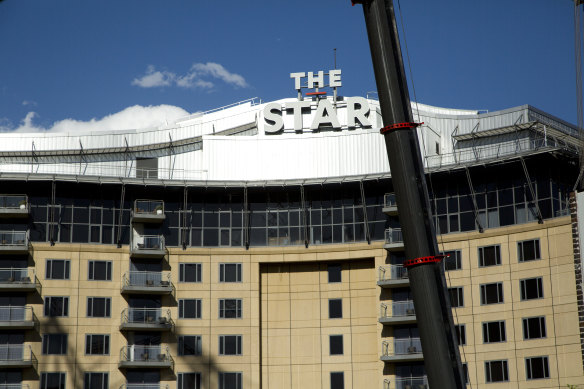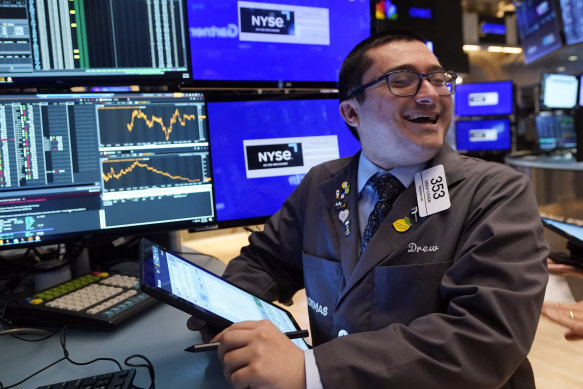- Updated
- Business
- Markets
- Sharemarket
This was published 6 months ago
ASX’s miners bounce back with best week since 2015; Star plunges 44%
By Staff reporter
Welcome to your five-minute recap of the trading day.
The numbers
The local bourse finished slightly up to close at a fresh all-time high, boosted by strong gains from the mining sector, which enjoyed its best week in nearly nine years.
The benchmark S&P/ASX 200 index ended Friday up 8.5 points, or 0.1 per cent, at an all-time closing high of 8212.2, while the broader All Ordinaries gained 14 points, or 0.17 per cent, to 8476.8.

Star shares plummeted on Friday.Credit: Ryan Stuart
The ASX 200 finished the week up slightly higher, the month up 1.5 per cent and the September quarter up 5.7 per cent – its best result since the fourth quarter of 2023.
The Australian dollar was buying US68.82¢, from US68.67¢ at Thursday’s ASX close.
The lifters
The mining sector rose 2.8 per cent on Friday and 9.4 per cent for the week, its best weekly performance since a 10.3 per cent gain in October 2015.
Miners have jumped with iron ore topping the $US100 mark in Singapore as it continued to climb on the back of Chinese stimulus measures that were announced earlier this week. BHP (up 3.2 per cent), Rio (up 3.4 per cent) and Fortescue (up 3.6 per cent) all ended the day sharply higher. Mineral Resources surged 13.9 per cent.
The tech sector was up by 0.4 per cent, while consumer staples rose 0.9 per cent. A2 Milk shares rose 8.7 per cent before being put in a trading halt so the Kiwi milk company could announce an acquisition.
The laggards
The Star (down 44.4 per cent) plunged almost in half in the company’s first trading day since last month. The ailing casino operator finally delivered its full-year results on Thursday, after snagging a last-ditch $200 million loan from its banks.
Star chief executive Steve McCann flagged hundreds of job cuts and the sale of assets such as hotels in Sydney, Brisbane and the Gold Coast as part of a complicated cost-saving plan following a $1.69 billion loss.
Supermarkets were mixed, with Woolworths up slightly (0.2 per cent) and Coles shed 0.5 per cent after a week of intense scrutiny.
In an ASX announcement, Woolworths Group chief executive Amanda Bardwell said the company believed the grocery sector was competitive and customers had more choice than ever, after a competition watchdog probe found the two biggest retailers, Coles and Woolworths acted as an “oligopoly” with limited incentive to compete on price. A Coles spokesperson said the company would examine the report, and it supported a diverse supermarket industry that offers choice and competitive prices.
Australia’s biggest alcohol retailer, Endeavour Group, was down 2.5 per cent on news its chief executive Steve Donohue was leaving. Donohue said it was “the right time” to leave the underperforming Dan Murphy’s and parent company BWS. Endeavour Group faces a dwindling stock value and its 2023/24 financial year results showed that although sales increased, profits had been slashed to service its $1.9 billion debt.
The heavyweight financial sector meanwhile finished 0.6 per cent lower, with all big four banks losing ground.
NAB fell 1.8 per cent, Westpac retreated 1.7 per cent, ANZ dropped 1 per cent, and CBA slid 0.1 per cent.
Oil prices sank after The Financial Times reported through sources that Saudi Arabia was preparing to abandon its unofficial price target of $US100 a barrel for crude. The price of a barrel of benchmark US crude fell 2.9 per cent to settle at $US67.67, while the international standard of Brent Crude fell 2.5 per cent to $US71.60.
Woodside Energy was 1.4 per cent lower while Santos slid by 1.2 per cent.
The lowdown
AMP Capital chief economist and head of investment strategy Shane Oliver said that despite this week’s performance on the markets, he thought the risk of a correction in shares remained high. He pointed to a range of risks including stretched valuations, investor optimism, the coming US election and conflict in the Middle East. At the same time, he said the trend towards stimulus globally – including interest rate cuts overseas – was positive for shares.
“The risk of a near-term pullback remains high for shares, but increasing policy stimulus globally as we move into a more positive seasonal period for shares is very supportive,” Oliver said.

Global markets rallied overnight.Credit: AP
Overnight, the S&P 500 added 0.4 per cent to set an all-time high for the third time this week and the 42nd time this year. The Dow Jones gained 260 points, or 0.6 per cent, to finish just shy of its record, while the Nasdaq Composite rose 0.6 per cent.
But drops for Exxon Mobil and other oil-and-gas companies kept the market’s gains in check.
The fall in oil prices overnight dragged Exxon Mobil’s stock down 1.7 per cent, and it was one of the heaviest weights on the S&P 500. ConocoPhillips sank 3.2 per cent.
In other sharemarkets overseas, indexes were more buoyant on hopes for more moves by China to prop up the world’s second-largest economy. The country’s powerful Politburo on Thursday called for intensified efforts as China tries to meet its goals for economic growth, according to the official Xinhua News Agency.
That follows a raft of announcements earlier in the week by the country’s central bank that had also sent global markets jumping. China’s economic growth has been flagging, and officials appear to be making a more coordinated effort following earlier piecemeal attempts to boost it.
In the United States, meanwhile, more encouraging news came after a round of reports on Thursday suggested the world’s largest economy may be doing better than expected.
Fewer US workers applied for unemployment benefits last week in the latest signal that layoffs remain relatively low across the economy. A separate report said the overall US economy grew at a 3 per cent annual rate during the spring, as previously estimated. That’s a solid rate.
The hope on Wall Street is for a form of financial nirvana where the US economy’s growth can hold steady and keep profits for companies humming while the Federal Reserve continues to lower interest rates.
Quote of the day
“Australia is already at about $1 trillion [in trade] and that will grow to about $1.5 trillion ... I’m talking of around 2030. So collectively we will be at about $5.5 trillion, and we should aim for 10 per cent of that to come from Australia and India. Let’s aim big – given the huge trust between the two countries, I would think we should go for it,” says India’s Commerce and Industry Minister, Piyush Goyal.
You may have missed
Australians are paying 20 per cent more for groceries than they were five years ago, with fresh fruit and vegie suppliers squeezed the most by the major supermarket chains, the competition watchdog said in a new report that described the supermarket sector as an oligopoly.
With AP
The Market Recap newsletter is a wrap of the day’s trading. Get it each weekday afternoon.